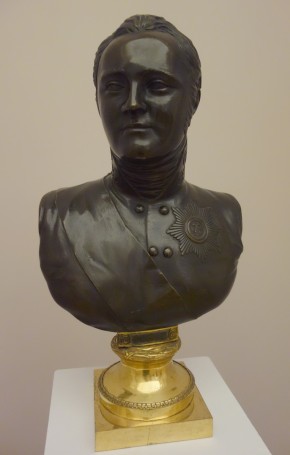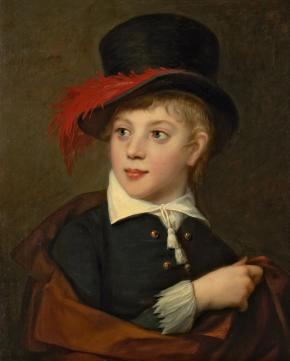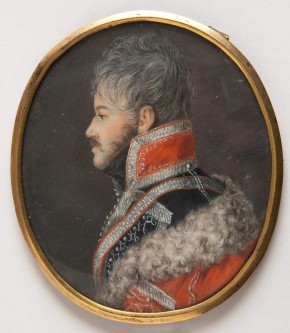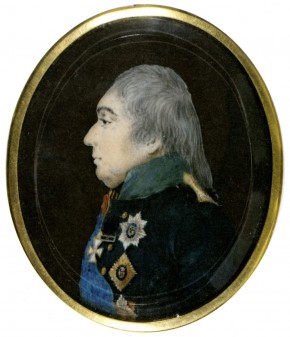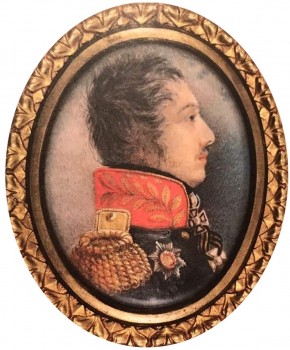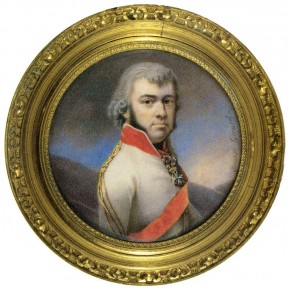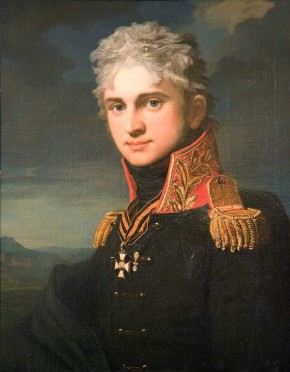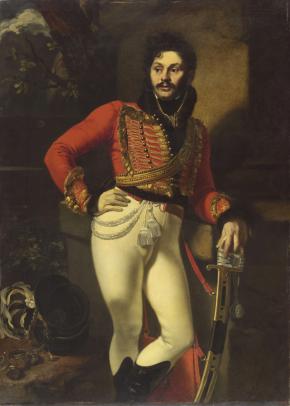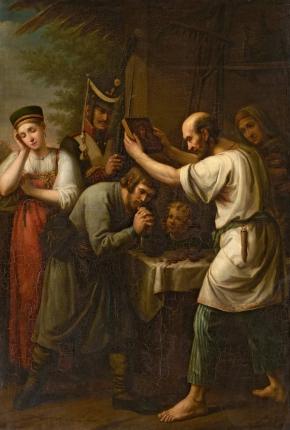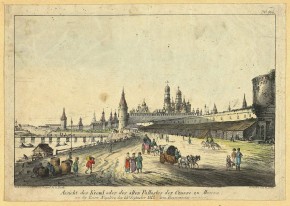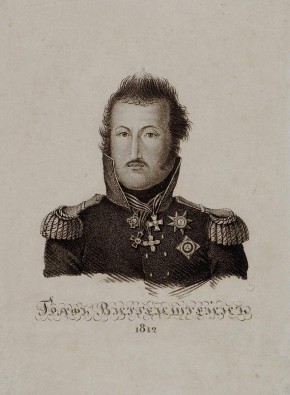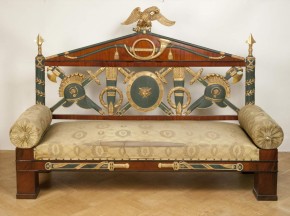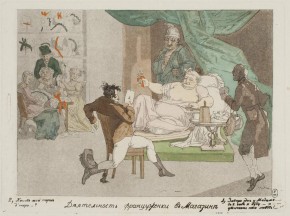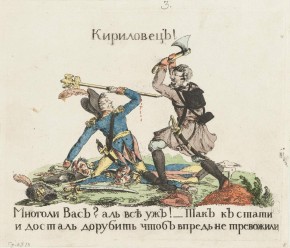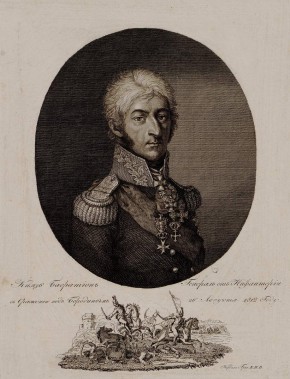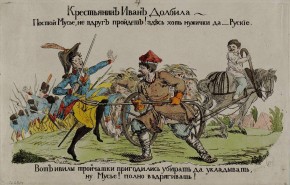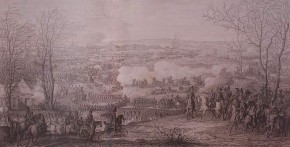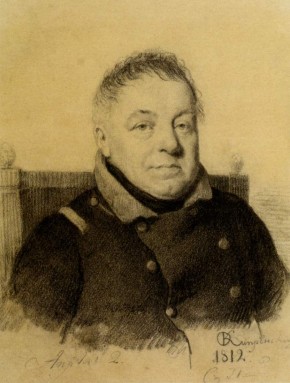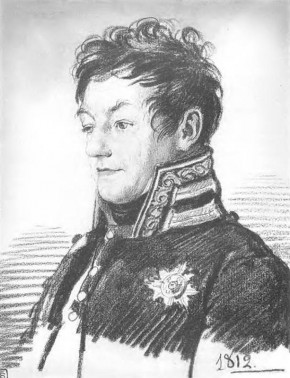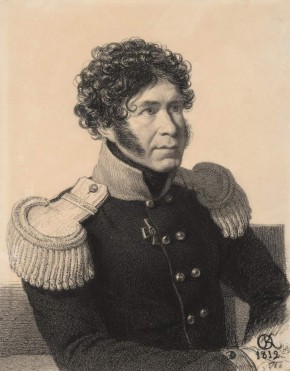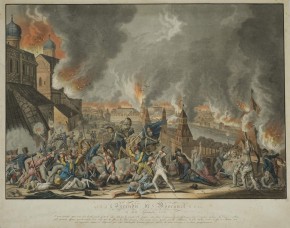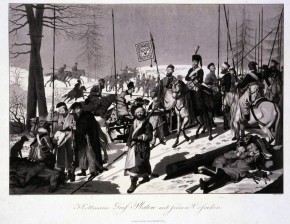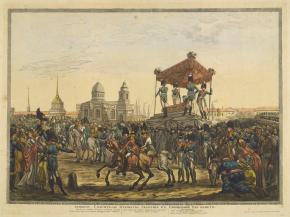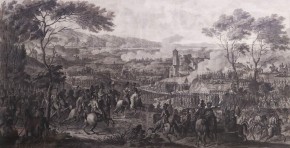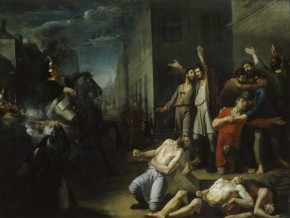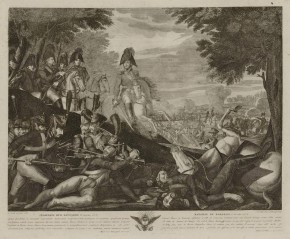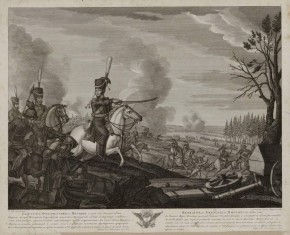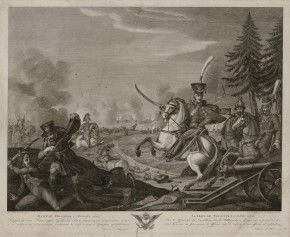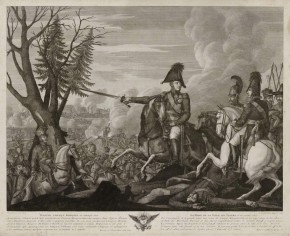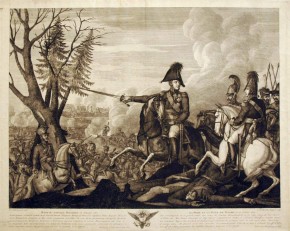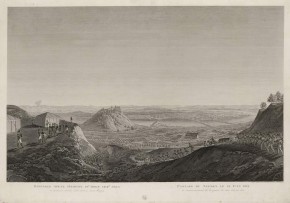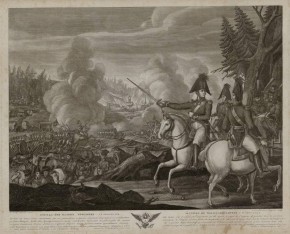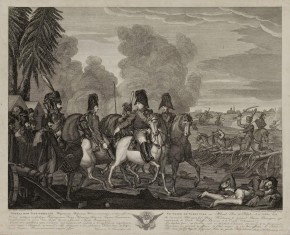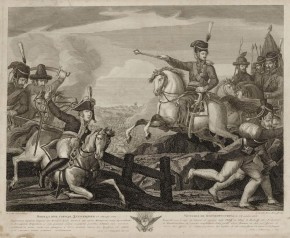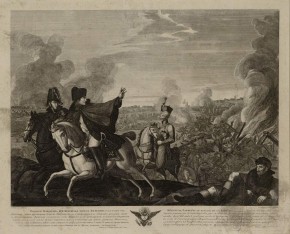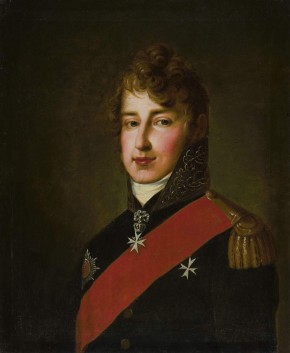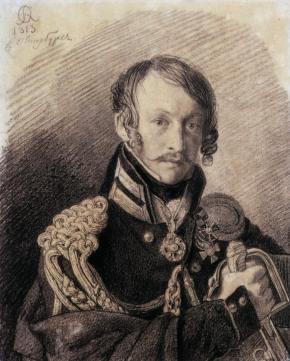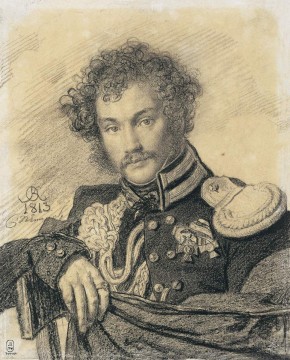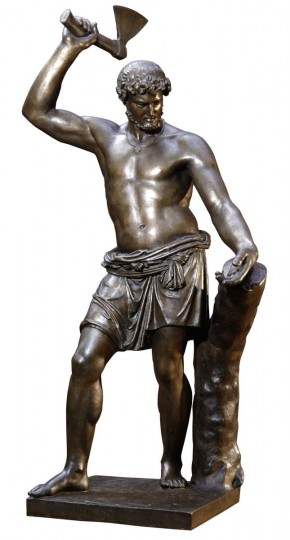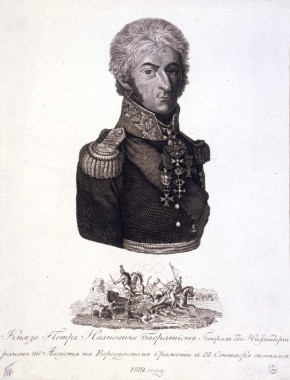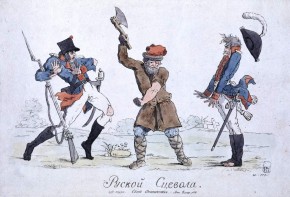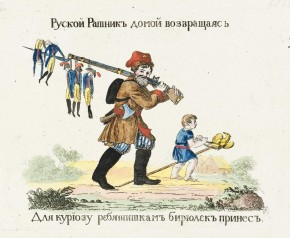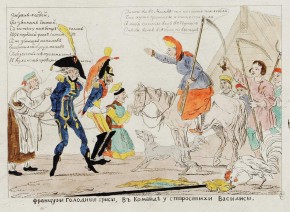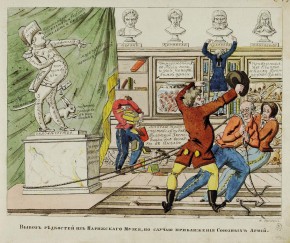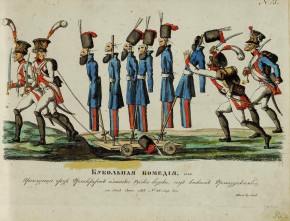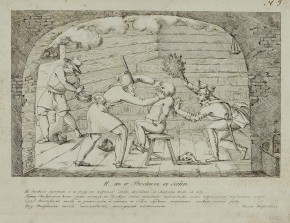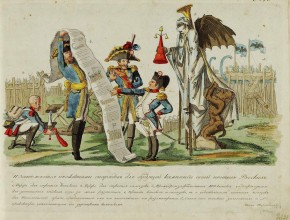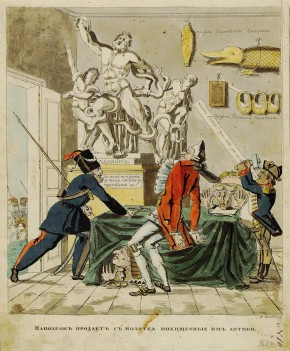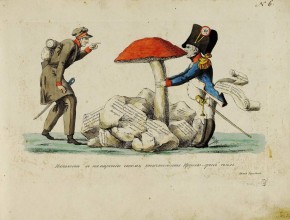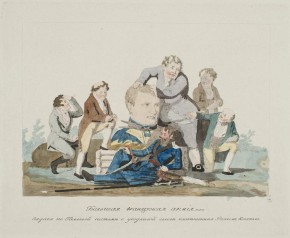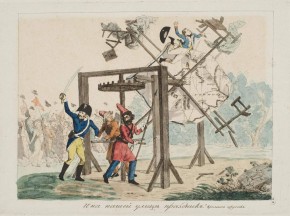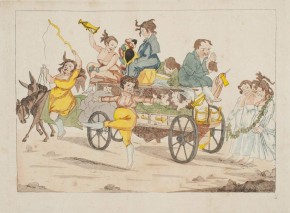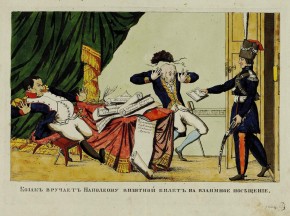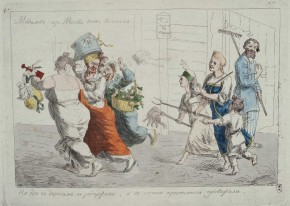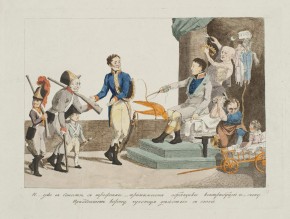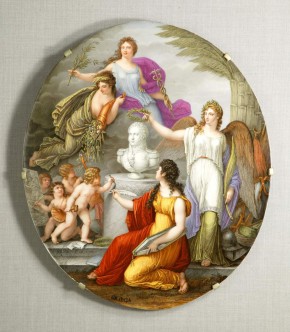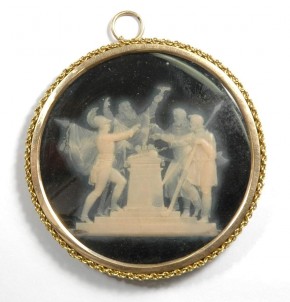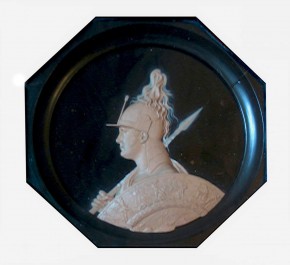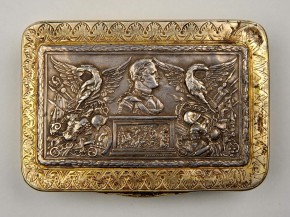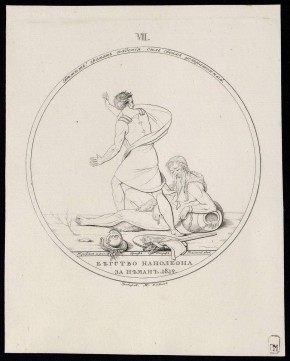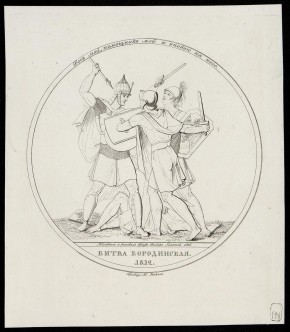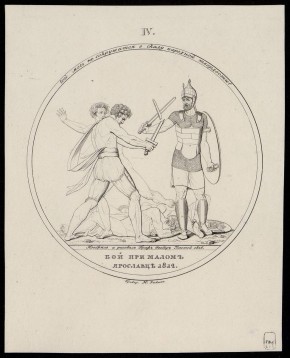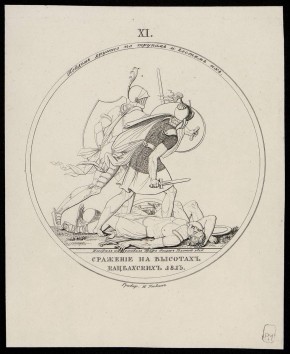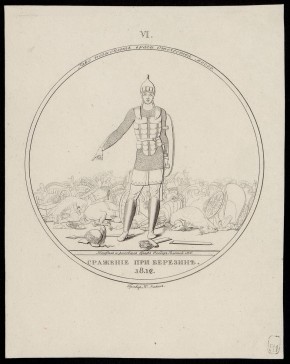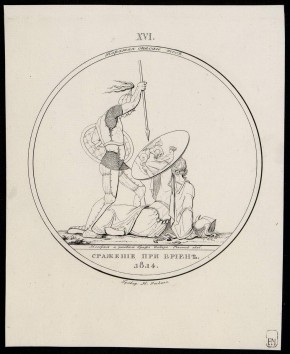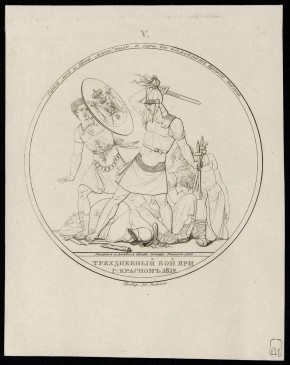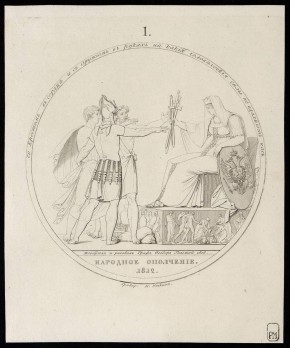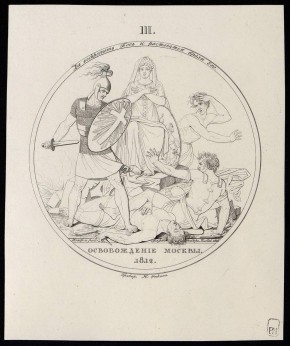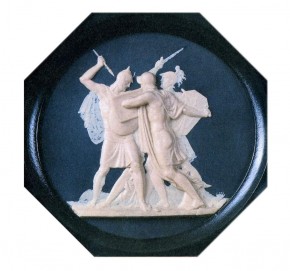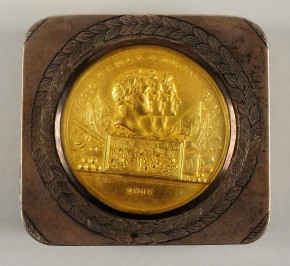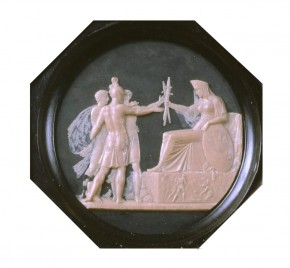Advanced search collections
1812 in Works of Art from the Collection of the Russian Museum
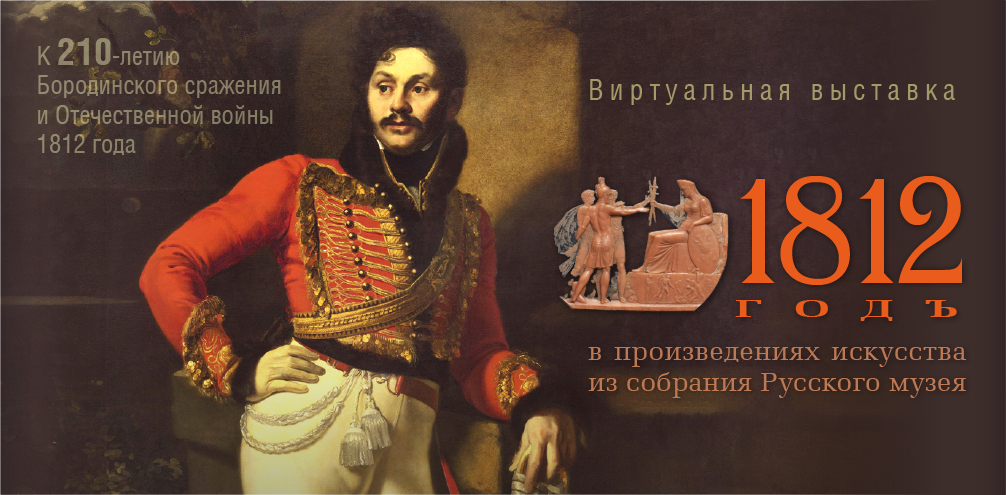
Portrait of Alexander I
- Early 19th century
- Bronze.
- The State Russian Museum
- Ск-973
Portrait of Alexander Stroganov
- Canvas, oil.
- The State Russian Museum
- Ж-4594
Count Alexander Stroganov (1794-1814) was the only son of Sofia and Pavel Stroganovs. He went to the army in the field with his father during the Patriotic War of 1812. He was tragically killed during the Battle of Craonne in France (A shot from a cannon decapitated him).
Портрет П. В. Голенищева-Кутузова
- Bone, watercolour, gouache.
- The State Russian Museum
- Ж-369
Портрет М. И. Голенищева-Кутузова
- 1806
- Bone, watercolour, gouache.
- The State Russian Museum
- Ж-820
Портрет П. Х. Витгенштейна
- Watercolour, gouache.
- The State Russian Museum
- Ж-463
Портрет князя Б. А. Голицына
- Bone, watercolour, gouache.
- The State Russian Museum
- Ж-346
Portrait of Count Pavel Stroganov
- 1808
- Canvas, oil. 69 х 56,5
- The State Russian Museum
- Ж-4596
Pavel Stroganov (1772–1817) was count and son of Alexander Stroganov and Yekaterina Petrovna (née Trubetskaya). He traveled a great deal around Russia. He went to Switzerland in order to complete his education and went to Paris in 1789. He took part in events of the French Revolution. He was called back to Russia in 1790. He became a gentleman in waiting in 1798. He was a member of the Private Committee at the beginning of the reign of Alexander I. He was also the assistant of the Minister of the Internal Affairs. He became a senator in 1806. He fought in the Finnish War (1808-1809), the Russo-Turkish War (1806-1812) and the Patriotic War of 1812.
Portrait of Life Guard Colonel Yevgraf Davydov
- 1809
- Canvas, oil. 162 x 116
- The State Russian Museum
- Ж-5134
The portrait is Orest Kiprensky’s most famous canvas and a specific manifesto of the art of the Romantic era in Russia. It was one of the works for which Kiprensky was made an academician in 1812.
Yevgraf Davydov (1775–1823): Sergeant major of the Life Guards Cavalry Regiment (1791), cornet of the Life Guards Hussar Regiment (1799), colonel (1807). Fought in the Napoleonic Wars at the Battle of Austerlitz (1805) and the Battle of Ostrovnoye near Vitebsk (1812). Lost his left leg and right arm beneath the elbow at the Battle of Leipzig (August 1813), awarded the Order of St George (3rd class), the Order of Leopold of Austria, the Order of the Red Eagle of Prussia (2nd class) and promoted to the rank of major-general. Russian Museum: From Icons to the Modern Times. Palace Editions, St Petersburg, 2015. P. 115.
Blessing a Militiaman in 1812
- 1810s
- Canvas, oil. 78 х 65
- The State Russian Museum
- Ж-3334
The war with Napoleon’s army gave rise to many works dedicated to various events and episodes, including this painting by Ivan Luchaninov, done for a programme given to pupils of the Academy of Arts. For this painting, he received a medal and the title of Academician.
Вид Кремля во время нашествия Наполеона в 1812 году
- Paper, .
- The State Russian Museum
- Гр.-20822
Граф Витгенштейн
- 1812
- Paper, , .
- The State Russian Museum
- Гр.-15171
Два кресла и диван
- Carving, gilding, .
- The State Russian Museum
- Меб.-679, Меб.-680, Меб.-677 (диван)
Деятельность француженки в магазине
- 1812
- Paper, coloured etching.
- The State Russian Museum
- Гр.-8753
Кириловец
- 1812
- Paper, coloured etching.
- The State Russian Museum
- Гр.-6913
Князь Багратион. Генерал от инфантерии в сражении под Бородиным 6 авг. 1812 года
- Paper, .
- The State Russian Museum
- Гр.-15061
Крестьянин Иван Долбила
- 1812
- Paper, coloured etching.
- The State Russian Museum
- Гр.-6914
Поражение корпуса маршала Даву 5 ноября 1812 года при городе Красном
- 1812–1813
- Paper, charcoal pencil. 55,3 х 96,4
- The State Russian Museum
- Р-5976
Портрет П. И. Меллер-Закомельского
- 1812
- Paper, italian pencil, charcoal pencil. 29,8 х 22,4
- The State Russian Museum
- Р-1056
Портрет военного врача
- 1812
- Paper, italian pencil, graphite pencil. 22,3 x 17,6
- The State Russian Museum
- Р-1061
Портрет генерала Д. В. Вындомского
- 1812
- Paper, italian pencil, charcoal pencil. 32,2 х 25,6
- The State Russian Museum
- Р-1051
Unknown sculptor
Mosnier Jean Laurent
1743 (4?), Paris — 1808, St PetersburgFrench painter, portraitist, miniaturist. Pupil of Louis-Jean-François Lagrenée the Elder. Court painter to Queen Marie Antoinette and Louis XVI. Contributed to the Paris Salon. Admitted into the Paris Academy of Arts in 1788. Fled to London during the French Revolution. Worked in Russia (1795(6?)–1808). Moved to St Petersburg (1795(6?)). Academician of the Imperial Academy of Arts (1802), headed the portrait class (from 1806).
Рокштуль Петер Эрнст
Unknown painter
Жирар Эрнест Жозеф Анжелон
Kiprensky Orest Adamovich
1772, Nezhinskaya (St Petersburg Province) - 1836, RomePortraitist, history painter, draughtsman.
Illegitimate son of a serf woman, Anna Gavrilova, who gave him the name Kipreisky, later changed to Kiprensky. Grew up in the family of his foster father Adam Schwalde. Emancipated from serfdom and enrolled in the Imperial Academy of Arts (1788). Studied history painting under Grigory Ugryumov and Gabriele-Francois Doyen. Fellow of the Imperial Academy of Arts (1803-09). Worked in St Petersburg, Moscow and Tver. Academician of portrait painting (1812), councillor of the Imperial Academy of Arts (1815). Contributed to the exhibitions of the Imperial Academy of Arts. Lived in Italy (1816-23, 1828-36). Contributed to the Paris Salon (1822). Donated Self-Portrait (1820) to the Galleria degli Uffizi in Florence (1825). Appointed second-class professor of history and portrait painting with automatic member¬ship of the nobility (1831). Councillor of the Accademia di Belle Arti in Naples (1831). Buried at Sant\'\' Andrea delle Fratte in Rome.
Адам Анри-Альберт (Андрей Александрович)
Venetsianov Alexei Gavrilovich
1780, Moscow - 1847, Poddubie (Tver Province)Founding father of Russian peasant genre painting. Painter, portraitist, etcher, lithographer. Son of a Moscow merchant, educated at private boarding school, worked as a draughtsman. Moved to St Petersburg (1802) and worked as a land surveyor for the crown properties and forestry departments. Studied painting independently, copied works in the Imperial Hermitage and drew pastel portraits. Academician (1811). Resigned from the civil service, moved to the country and painted genre scenes from life (early 1820s). Exhibited at the Imperial Academy of Arts and the Society for the Encouragement of Artists. Had many students, who formed the Venetsianov school in Russian art. Killed in a road accident at the Milyukov estate.
Карделли Сальватор (Cardelli Salvator) / Соломон
Luchaninov Ivan Vasilievich
1781, Toropets (Pskov Province) ‒ 1824, St PetersburgPainter, history painter, portraitist, icon painter. Audited classes at the Imperial Academy of Arts (until 1809), student of Stepan Shchukin and Alexander Warnek. Helped to paint icons for the Kazan Cathedral (before 1812). Awarded a major gold medal and fellowship at the Imperial Academy of Arts (1812).
Blessing a Militiaman in 1812
- 1810s
- Canvas, oil. 78 х 65
- The State Russian Museum
- Ж-3334
The war with Napoleon’s army gave rise to many works dedicated to various events and episodes, including this painting by Ivan Luchaninov, done for a programme given to pupils of the Academy of Arts. For this painting, he received a medal and the title of Academician.
Поражение корпуса маршала Даву 5 ноября 1812 года при городе Красном
- 1812–1813
- Paper, charcoal pencil. 55,3 х 96,4
- The State Russian Museum
- Р-5976
The Entry of the French Army into Moscow 14 September 1812
- Paper, etching, lathe.
- The State Russian Museum
- Гр.-35167
The Fire of Moscow on 15 September 1812
- Paper, aquatint with hand colouring.
- The State Russian Museum
- Гр.-32009
Атаман граф Платов со своими казаками
- Paper, .
- The State Russian Museum
- Гр.-17327
Вид ввезения в С.-Петербург на раменах Кутузова-Смоленского
- etching, aquatint with hand colouring.
- The State Russian Museum
- Гр.-38369
Поражение корпуса генерала Вандама 18 августа 1813 года при селе Кульме
- 1813
- Paper, charcoal pencil. 56,1 х 96,6
- The State Russian Museum
- Р-5977
Расстрел французами русских патриотов в Москве в 1812 году
- 1813
- Canvas, oil. 140 х 188
- The State Russian Museum
- Ж-5056
"Сражение при Бородине 26 августа 1812 г."
- Paper, .
- The State Russian Museum
- Гр.-17382
Бегство французов из Москвы в 1812 году октября 12 дня
- 1814
- Paper, .
- The State Russian Museum
- Гр.-17386
Взятие Полоцка 6 октября 1812 г.
- Paper, .
- The State Russian Museum
- Гр.-17384
Взятие города Вязьмы 22 октября 1812
- 1814
- Paper, .
- The State Russian Museum
- Гр.-17388
Взятие города Вязьмы 22 октября 1812 года
- 1814
- Paper, .
- The State Russian Museum
- Гр.-31373
Переход через Неман 12 июня 1812-го года и начало войны 1812-го, 1813-го и 1814-го года
- .
- The State Russian Museum
- Гр.-31727
Победа при Колотском монастыре 19 октября 1812 г
- Paper, .
- The State Russian Museum
- Гр.-17387
Победа при Малом Ярославце 12 октября 1812 г.
- Paper, .
- The State Russian Museum
- Гр.-17385
Победа при Тарутине над Мюратом, королем Неаполитанским, 6 октября 1812 г.
- Paper, .
- The State Russian Museum
- Гр.-17383
Победа при городе Духовщине 26 октября 1812 г
- Paper, .
- The State Russian Museum
- Гр.-17389
Разбитие Наполеона при переправе через Березину 16 и 17 ноября 1812 г
- Paper, .
- The State Russian Museum
- Гр.-17392
Разбитие маршала Виктора при г. Старом Борисове 15 и 16 ноября 1812 г
- 1814
- Paper, .
- The State Russian Museum
- Гр.-17393
Vasily Shebuev
Unknown engraver
Rugendas Johann Lorenz
Тихонов Михаил Тихонович
Jügel Johann Friedrich
Беггров Иван Петрович (Иоганн-Фридрих)
Klauber Ignaz Sebastian
Федоров Сергей
Portrait of Alexander I
- Early 19th century
- Bronze.
- The State Russian Museum
- Ск-973
Portrait of Alexander Stroganov
- Canvas, oil.
- The State Russian Museum
- Ж-4594
Count Alexander Stroganov (1794-1814) was the only son of Sofia and Pavel Stroganovs. He went to the army in the field with his father during the Patriotic War of 1812. He was tragically killed during the Battle of Craonne in France (A shot from a cannon decapitated him).
Портрет П. В. Голенищева-Кутузова
- Bone, watercolour, gouache.
- The State Russian Museum
- Ж-369
Портрет М. И. Голенищева-Кутузова
- 1806
- Bone, watercolour, gouache.
- The State Russian Museum
- Ж-820
Портрет П. Х. Витгенштейна
- Watercolour, gouache.
- The State Russian Museum
- Ж-463
Портрет князя Б. А. Голицына
- Bone, watercolour, gouache.
- The State Russian Museum
- Ж-346
Portrait of Count Pavel Stroganov
- 1808
- Canvas, oil. 69 х 56,5
- The State Russian Museum
- Ж-4596
Pavel Stroganov (1772–1817) was count and son of Alexander Stroganov and Yekaterina Petrovna (née Trubetskaya). He traveled a great deal around Russia. He went to Switzerland in order to complete his education and went to Paris in 1789. He took part in events of the French Revolution. He was called back to Russia in 1790. He became a gentleman in waiting in 1798. He was a member of the Private Committee at the beginning of the reign of Alexander I. He was also the assistant of the Minister of the Internal Affairs. He became a senator in 1806. He fought in the Finnish War (1808-1809), the Russo-Turkish War (1806-1812) and the Patriotic War of 1812.
Portrait of Life Guard Colonel Yevgraf Davydov
- 1809
- Canvas, oil. 162 x 116
- The State Russian Museum
- Ж-5134
The portrait is Orest Kiprensky’s most famous canvas and a specific manifesto of the art of the Romantic era in Russia. It was one of the works for which Kiprensky was made an academician in 1812.
Yevgraf Davydov (1775–1823): Sergeant major of the Life Guards Cavalry Regiment (1791), cornet of the Life Guards Hussar Regiment (1799), colonel (1807). Fought in the Napoleonic Wars at the Battle of Austerlitz (1805) and the Battle of Ostrovnoye near Vitebsk (1812). Lost his left leg and right arm beneath the elbow at the Battle of Leipzig (August 1813), awarded the Order of St George (3rd class), the Order of Leopold of Austria, the Order of the Red Eagle of Prussia (2nd class) and promoted to the rank of major-general. Russian Museum: From Icons to the Modern Times. Palace Editions, St Petersburg, 2015. P. 115.
Blessing a Militiaman in 1812
- 1810s
- Canvas, oil. 78 х 65
- The State Russian Museum
- Ж-3334
The war with Napoleon’s army gave rise to many works dedicated to various events and episodes, including this painting by Ivan Luchaninov, done for a programme given to pupils of the Academy of Arts. For this painting, he received a medal and the title of Academician.
Граф Витгенштейн
- 1812
- Paper, , .
- The State Russian Museum
- Гр.-15171
Князь Багратион. Генерал от инфантерии в сражении под Бородиным 6 авг. 1812 года
- Paper, .
- The State Russian Museum
- Гр.-15061
Портрет П. И. Меллер-Закомельского
- 1812
- Paper, italian pencil, charcoal pencil. 29,8 х 22,4
- The State Russian Museum
- Р-1056
Портрет военного врача
- 1812
- Paper, italian pencil, graphite pencil. 22,3 x 17,6
- The State Russian Museum
- Р-1061
Портрет генерала Д. В. Вындомского
- 1812
- Paper, italian pencil, charcoal pencil. 32,2 х 25,6
- The State Russian Museum
- Р-1051
Портрет князя Г.С. Голицына
- Canvas, oil. 67 х 56
- The State Russian Museum
- ЖБ-477
Portrait of Aleksey Lanskoi
- 1813
- Paper, italian pencil. 25,5 х 20,8
- The State Russian Museum
- Р-2890
Portrait of Mikhail Lanskoi
- 1813
- Paper, italian pencil. 26 х 20,7
- The State Russian Museum
- Р-13128
Mikhail Lanskoi (circa 1787—?): Saw action in the military campaigns of 1806—07 and the Patriotic War of 1812. Served in Saratov. Commanded a Hussar division in Kovno (1832). Nephew of Alexei Tomilov, whom he helped to put his art collection together. Depicted with the Orders of St George (4th class) and St Vladimir (4th class). Awarded the St George’s Cross in June 1807. Russian Museum: From Icons to the Modern Times. Palace Editions, St Petersburg, 2015. P. 109.
Russian Scaevola
- Bronze.
- The State Russian Museum
- Ск-1859
The sculptor portrayed the feat of an unknown peasant, who, according to a legend, was captured by the French during the war of 1812. The hero was particularly athletic and therefore he was taken to serve in the French army, and as a sign that he belonged to the Emperor Napoleon, he was branded with the initial "N". The peasant didn’t want to serve the enemies of his Fatherland, so he cut off his hand with an ax. Such courage caused respect from the enemy, and he was released.
The sculptor compares the act of this Russian peasant with the feat of the ancient Roman Gaius Mucius Scaevola, who in 508 BC sacrifices his hand in the name of saving the homeland. In accordance with the norms of classicism, the author ennobles the face of the hero: he has clayey features, his expression is calm, the body is composed harmoniously. Only a cross on his neck indicates that he is not an ancient warrior, but a Russian hero.
Атаман граф Платов со своими казаками
- Paper, .
- The State Russian Museum
- Гр.-17327
Князь П. И. Багратион
- Paper, .
- The State Russian Museum
- Гр.-16283
Demut-Malinovsky Vasily
1779, St Petersburg — 1846, St PetersburgSculptor. Studied at the Imperial Academy of Arts (1785–1800). Fellow of the Imperial Academy of Arts in Rome (1803–1806). Taught at the Imperial Academy of Arts (from 1808). Professor (from 1813), chancellor of the sculpture department (from 1836). Oversaw the sculpture of palaces and parks in St Petersburg. Author of many ornamental and monumental works decorating St Petersburg’s buildings, indoor and memorial sculptures as well.
Деятельность француженки в магазине
- 1812
- Paper, coloured etching.
- The State Russian Museum
- Гр.-8753
Кириловец
- 1812
- Paper, coloured etching.
- The State Russian Museum
- Гр.-6913
Крестьянин Иван Долбила
- 1812
- Paper, coloured etching.
- The State Russian Museum
- Гр.-6914
Русский Сцевола
- 1812
- Paper, coloured etching.
- The State Russian Museum
- Гр.-8777
Русский ратник, домой возвращаясь, для курьезу ребятишкам бирюлек принес
- 1812
- Paper, coloured etching.
- The State Russian Museum
- Гр.-6780
Французы голодные крысы в команде у старостихи Василисы
- 1812
- Paper, coloured etching.
- The State Russian Museum
- Гр.-6793
"Вывоз редкостей из Парижского музея по случаю приближения союзных армий"
- Paper, coloured etching.
- The State Russian Museum
- Гр.-322
"Кукольная комедия"
- Paper, coloured etching.
- The State Russian Museum
- Гр.-317
«Консилиум»
- Paper, coloured etching.
- The State Russian Museum
- Гр.-324
«Наполеон в Русской бане»
- Paper, etching.
- The State Russian Museum
- Гр.-313
«Наполеон занимается прожектами снарядов для будущей кампании своей против Русских»
- Paper, coloured etching.
- The State Russian Museum
- Гр.-319
«Наполеон продает с молотка похищенные им антики»
- Paper, coloured etching.
- The State Russian Museum
- Гр.-320
«Наполеон, в намерении своем уничтожить Пруссию, гриб съел»
- Paper, coloured etching.
- The State Russian Museum
- Гр.-310
Большая французская армия...
- 1813
- Paper, coloured etching.
- The State Russian Museum
- Гр.-8762
И на нашей улице праздник! Кричит пруссак
- 1813
- Paper, coloured etching.
- The State Russian Museum
- Гр.-8757
Изгнание из Москвы французских актрис
- 1813
- Paper, coloured etching.
- The State Russian Museum
- Гр.-8761
Казак вручает Наполеону визитной билет на взаимное посещение
- Paper, coloured etching.
- The State Russian Museum
- Гр.-314
Мадамов из Москвы ведь выгнали
- 1813
- Paper, coloured etching.
- The State Russian Museum
- Гр.-8758
Н... уже в Сенате с трофеями...
- 1813
- Paper, coloured etching.
- The State Russian Museum
- Гр.-8773
Наполеон с сатаной после сожжения Москвы
- 1813
- Paper, coloured etching.
- The State Russian Museum
- Гр.-8796
Теребенев Иван Иванович
Шифляр Самуил Петрович
Ivanov Ivan
Два кресла и диван
- Carving, gilding, .
- The State Russian Museum
- Меб.-679, Меб.-680, Меб.-677 (диван)
Russian Scaevola
- Bronze.
- The State Russian Museum
- Ск-1859
The sculptor portrayed the feat of an unknown peasant, who, according to a legend, was captured by the French during the war of 1812. The hero was particularly athletic and therefore he was taken to serve in the French army, and as a sign that he belonged to the Emperor Napoleon, he was branded with the initial "N". The peasant didn’t want to serve the enemies of his Fatherland, so he cut off his hand with an ax. Such courage caused respect from the enemy, and he was released.
The sculptor compares the act of this Russian peasant with the feat of the ancient Roman Gaius Mucius Scaevola, who in 508 BC sacrifices his hand in the name of saving the homeland. In accordance with the norms of classicism, the author ennobles the face of the hero: he has clayey features, his expression is calm, the body is composed harmoniously. Only a cross on his neck indicates that he is not an ancient warrior, but a Russian hero.
Вид ввезения в С.-Петербург на раменах Кутузова-Смоленского
- etching, aquatint with hand colouring.
- The State Russian Museum
- Гр.-38369
Пласт «Апофеоз Александра I»
- 1813–1814
- Porcelain, overglaze decoration, gilding, . 41,5 х 36,9
- The State Russian Museum
- Ф-2181
Проект медали в память народного ополчения 1812 года
- 1813
- Gold, , bronze.
- The State Russian Museum
- Мед.А-12581
Родомысл девятого на десять века. Аллегорическое изображение Александра I
- 1813-1814
- .
- The State Russian Museum
- СК-995
Табакерка
- 1810s
- Silver, chasing, engraving, gilding. 2,3 х 9,7 х 7
- The State Russian Museum
- Сер-1098
"Бегство Наполеона за Неман 1812 г."
- 1816
- Paper, .
- The State Russian Museum
- Гр.-7281
"Битва Бородинская 1812 г."
- Paper, .
- The State Russian Museum
- Гр.-7276
"Бой при Кульме. 1813 г."
- 1816
- Paper, .
- The State Russian Museum
- Гр.-7283
"Бой при Малом Ярославце 1812 г."
- Paper, .
- The State Russian Museum
- Гр.-7278
"Сражение на высотах Кацбахских. 1813 г."
- 1816
- Paper, .
- The State Russian Museum
- Гр.-7282
"Сражение при Березине, 1812 г."
- Paper, .
- The State Russian Museum
- Гр.-7280
"Сражение при Бриене. 1814 г."
- 1816
- Paper, .
- The State Russian Museum
- Гр.-7284
"Трехдневный бой г. Красном 1812 г."
- Paper, .
- The State Russian Museum
- Гр.-7279
I. "Народное ополчение 1812 г."
- Paper, .
- The State Russian Museum
- Гр.-7275
III. "Освобождение Москвы 1812 г."
- .
- The State Russian Museum
- Гр.-7277
Битва Бородинская, 1812 год
- 1816
- .
- The State Russian Museum
- СК-524
Коробка
- 1816
- Silver, copper, chasing, engraving, , gilding, . 2,1 х 7,8 х 7,3
- The State Russian Museum
- Сер-1079
Народное ополчение 1812 г. Барельеф
- 1816
- .
- The State Russian Museum
- СК-523
